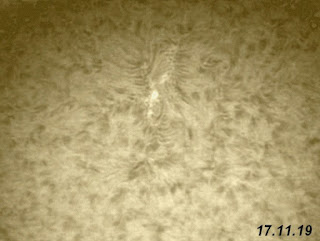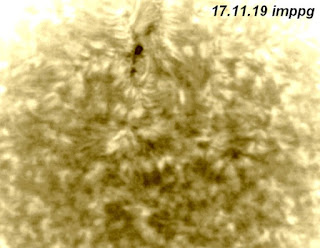*
 Sunday am: 11:00 41F. Weak sunshine with wind and some cloud increasing. Several modest prominences and one, paler, disturbed region in the solar southern hemisphere. It feels cold in the dome due to the wind.
Sunday am: 11:00 41F. Weak sunshine with wind and some cloud increasing. Several modest prominences and one, paler, disturbed region in the solar southern hemisphere. It feels cold in the dome due to the wind.
I have captured lots of videos but Registax is misbehaving. In a desperate bid to have something to show for my efforts I tried AS!3 [Autostakkert] and iMPPG to process some results. Then tried harder in PhotoFiltre to augment the final image. I usually, recolour the final images in PhotoFiltre7. Not with any great success. As can be seen on the right. Realistic sharpness of the final image still eludes me. Yet, the image cannot be sharpened artificially without producing digital artefacts. I am usually using 640x480.
 The next image shows how imppg can bring out a 3D effect from exactly the same image. Though still not crisply.
The next image shows how imppg can bring out a 3D effect from exactly the same image. Though still not crisply.Spreading the detail outwards requires a delicate touch and probably a lot more practice. Subtlety is not remotely easy to achieve. I have no clue as to the desirable settings and can't ever remember the details from the guides. The "chrysanthemum" effect arrived by sheer chance. As I played with the wiggly lines laid over the histogram on the right in iMPPG.
The third image is a photograph taken straight from my 25" monitor. It shows the active imaging screen in SharpCap. The "live" detail and huge scale is obvious. Though, in reality, is subject to various degrees of thermal tremors. Which a still photo cannot capture. Note the variation in brightness over the vertical depth of the frame.
 I don't have any software to even out this variation. Though I believe Photoshop does. Having just watched an expert's video on using Photoshop to augment a solar image I am almost grateful that I don't have Photoshop. The number of steps, choices and selections is well past my sell-by date. I struggle to remember the basics of Registax and Autostakkert! I have the memory of a net.
I don't have any software to even out this variation. Though I believe Photoshop does. Having just watched an expert's video on using Photoshop to augment a solar image I am almost grateful that I don't have Photoshop. The number of steps, choices and selections is well past my sell-by date. I struggle to remember the basics of Registax and Autostakkert! I have the memory of a net. "Lucky imaging" software is supposed to iron out the differences between the [software] chosen frames of the captured video. The faster the video camera the shorter the time span for avoiding camera shake or poor guiding. The faster the camera the more frames can be captured in a given time span. More frames means more data.
Camera speed is highly dependent on image brightness and frame size. A 640x480 frame of the solar surface in H-alpha can mean 350fps with the ASI174. While a small fraction of the limb with a dim prominence can mean the camera drops right back to 30fps. Prominences are usually made visible by over-exposure of the solar surface in H-alpha. It is not possible to see them in white light with normal, amateur equipment.
Camera speed is also dependent on the computer hardware. USB3, short cable lengths and a really fast hard drive [SSD] are important. The file sizes for video capture can be enormous as frame size increases. I rarely use the full 1936x1216 for video capture in SharpCap. Reserving the full frame only for finding objects. Things like the Sun and Moon. Which are elusive when Goto means something else altogether.
Click on any image for an enlargement.
*
No comments:
Post a Comment